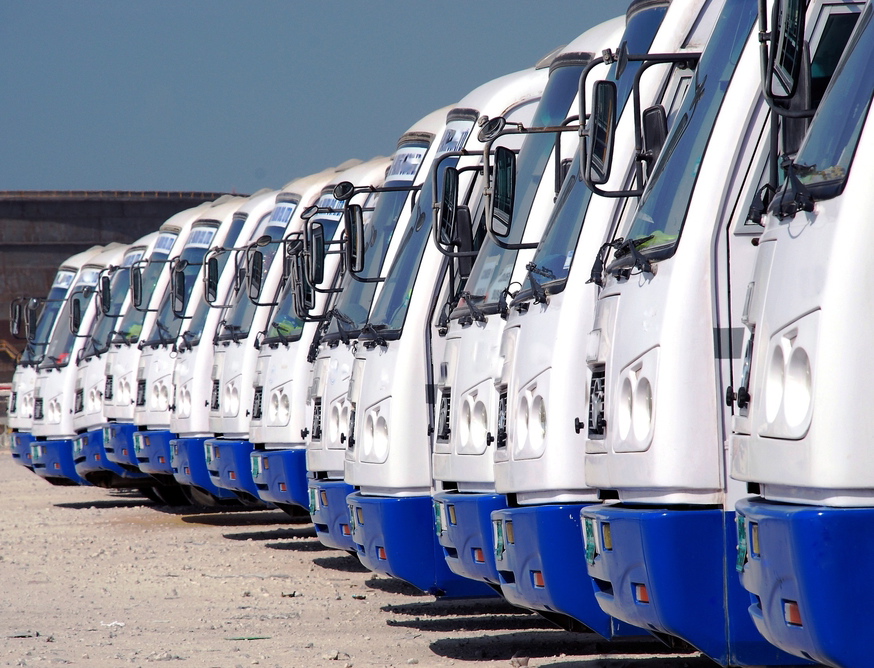
Want more great analysis of electric and sustainable transport? Sign up for Transport Weekly, our free email newsletter.
The U.S. federal fleet — with its 645,000 vehicles — is going all-electric. At least, that's the plan from a Biden administration executive order issued last month.
The goal highlights how 2021 is the year that companies and government organizations will try to transition from piloting a couple of electric vehicles in their fleets to building much more comprehensive, scaled-up and potentially 100 percent electric vehicle strategies. But as fleet electrification moves past the early pilot phase, major challenges remain.
What hurdles should companies and organizations be on the lookout for? RMI analyst Chris Nelder and his team just released a comprehensive (and free) report on fleet electrification and its challenges. Here are five of the biggest red flags you should watch out for:
1. The utility and fleet gap: Utility grid planning tends be a long process. The RMI report found it could take 18 to 24 months for a utility to review and approve an organization's EV resource grid plan. If the utility is required to provide megawatts of new grid capacity for an organization's EV plan, then discussions should start three years in advance, says RMI.
This long lead time is particularly frustrating for the largest and most aggressive fleets who want to move quickly and electrify large portions of their fleets. At VERGE 20, fleet managers from Amazon and FedEx Express confirmed that the utility lag time is one of their biggest bottlenecks for fleet electrification.
So what's the solution? Companies should engage utilities as soon as possible in the planning process. The most progressive utilities also have started to develop fleet outreach strategies to make sure utilities are involved with the earliest stages of EV fleet planning.
It’s essential to begin implementing processes for appropriate cost allocation and capital planning on an organization-wide basis immediately.
Southern California Edison's Jill Anderson, senior vice president of customer service, says that SCE "encourages customers to come talk to us when they’re thinking about fleet electrification."
For example, SCE has been working closely with the city of Porterville, California, to help with a project to electrify 60 buses, both transit and school buses. We're "working together to figure out the best locations [for charging] and do it in the most cost-effective and fastest way."
2. New business and budgeting processes: The way fleet managers fund, procure and operate electric fleets and the accompanying charging infrastructure can be very different from how organizations historically have been buying and fueling diesel-powered vehicles. For many organizations, funding for the vehicles and the chargers come out of two budgets, and many organizations never have had a line item for chargers before.
RMI says: "It’s essential to begin implementing processes for appropriate cost allocation and capital planning on an organization-wide basis immediately. A cross-functional team of staff from fleets, operations, facilities, finance and purchasing departments with executive leadership support should collaborate to understand the [total cost of ownership] TCO of fleet electrification accurately."
3. Moving beyond Level 2 charging: The most confusing aspect of fleet electrification is deploying charging infrastructure. Many fleets that have a couple of EVs are using inexpensive Level 2 chargers or even shared public charging stations.
But as more organizations transition larger portions of their fleets to EVs, they'll likely need some type of fast chargers, depending on the use case of the vehicles and the number of vehicles that need charging.
Fast chargers are more expensive than Level 2 chargers but can add significant charging in just 20 to 30 minutes, compared to the eight-plus hours it can take to fully charge an EV with a Level 2 charger. A small number of fast chargers for a fleet also can act as a way to help fleets have more confidence in an EV transition.
4. Lack of data: Many fleets are finding they can't fully determine the full TCO for their EVs in comparison to their diesel-powered fleets because of a lack of data around charging and EV maintenance costs. Fleets need to deploy telematics and charging software systems early in the process to make sure they're making decisions that make economic sense.
5. Incremental vs. planned charging deployments: RMI noted that in early pilot phases of electric fleets, it's common for an organization to buy a couple of EVs and the accompanying Level 2 chargers. However, as fleets move beyond the pilot phase, organizations need to comprehensively plan out large EV charger procurement and deployments.
Why can't fleets opt for piecemeal buying and deploying? Because it ends up being much more expensive.
If a fleet manager ends up opting for 100 percent EVs but deploys them in an ad-hoc way, they can end up spending hundreds of thousands of dollars more in both upfront costs and costs over the life of the systems.
The RMI report is a good read. I encourage anyone interested to download and read the entire 69-page piece.
"electric" - Google News
February 10, 2021 at 04:35PM
https://ift.tt/3tD5PGC
The secret to moving past electric vehicle pilots | Greenbiz - GreenBiz
"electric" - Google News
https://ift.tt/2yk35WT
https://ift.tt/2YsSbsy
Bagikan Berita Ini















0 Response to "The secret to moving past electric vehicle pilots | Greenbiz - GreenBiz"
Post a Comment